An insatiable appetite for ancient and modern tongues


Classification: Indo-European, Baltic, East-Baltic. Western Baltic languages, including Prussian and others, are all extinct. Lithuanian and Baltic belong to the eastern branch along with some extinct languages.
Overview. Lithuanian, one of two extant Baltic languages, is archaic in many respects such as shown by its complex declension of nouns, pronouns and adjectives. It is closely related to Latvian (the other living Baltic member), and has been greatly influenced by the Slavic languages since the Middle Ages when Lithuania was in the orbit of Poland.
Distribution and Speakers. There are about three million speakers in Lithuania and smaller numbers in neighboring Latvia (35,000), Belarus (10,000), the Russian exclave of Kaliningrad (7,000), and Poland (30,000). Another 40,000 Lithuanians live in other parts of Russia and many have migrated to more distant countries, mainly to the United States (40,000).
Varieties. There are two major dialects: the more conservative Aukštaitic or High Lithuanian (spoken in the greatest part of Lithuania) and Žemaitic or Low Lithuanian (spoken in the northwest of the country). The standard language, formed in the second half of the 19th century, is based on West High Lithuanian which was, at that time, the most prestigious dialect. A literary language existed since the 16th century and was used in religious writings.
Status. Lithuanian is the official language of Lithuania since 1918.
Oldest Documents
1525. Translations of the Lord's Prayer, a creed, and the Ave Maria.
1547. A catechism published in Königsberg by Martynas Mažvydas.
1595-99. A catechism and a collection of sermons published in the Grand Duchy of Lithuania by Mikalojus Daukša.
1653. The first Lithuanian grammar (Grammatica Litvanica) authored by Daniel Klein.
Phonology
Vowels (10-11). Lithuanian has short and long vowels. Vowel length is phonemic.

[ɪ] is slightly lower and more centralized than [i:]; [ʊ] is slightly lower and more centralized than [u:].
[ɔ] is attested in words of foreign origin.
It has also 6 diphthongs: ei, ai, ui, au, ie, uo.
Consonants (45). One distinctive feature of Lithuanian (not found in Latvian) is the contrast between palatalized and non-palatalized consonants before back vowels. Before front vowels palatalization is automatic. Another contrast, manifested in all stops. affricates and fricatives, is between voiceless and voiced.

-palatalization is indicated in the table by an apostrophe (for the script see below).
-the opposition [t] vs [t'] and [d] vs [d'] is marginal. In native words [t'] and [d'] are found only before front vowels and are, therefore, automatic variants of [t] and [d].
-[ʧ] and [ʤ] are very rare and occur before back vowels replacing [t'] and [d'] .
-[f], [x], [ɣ] are found mainly in loanwords.
Stress: word stress is free and may carry morphological information; for example: žiemos stressed on the last syllable is genitive singular, and žiemos stressed on the first syllable is nominative plural. Accent is not marked orthographically though in some grammars and dictionaries is marked with a grave accent.
Tones. Lithuanian distinguish two contour tones applied to long vowels and diphthongs. They are only marked in dictionaries and grammars: falling tone with an acute accent, and rising tone with a tilde above the vowel or the consonants r, l, m, n. The grave accent occurs only in short vowels and doesn’t represent tone but stress only.
Script and Orthography
The Lithuanian alphabet is based on the Roman script. It has 32 letters, and vowel notation is somewhat redundant (for historical reasons). Three sounds are represented by three digraphs that are separate from the alphabet. Palatalization before back vowels is marked by the vowel i which in this case has no phonetic value. Before front vowels, consonants are automatically palatalized and no special marking is required.

Morphology
-
Nominal. Nouns are marked for gender, number and case; there are no articles.
-
•gender: masculine, feminine. The proto-Baltic neuter gender was lost except for some marginal forms. The inherent noun gender is expressed by agreement with adjectives, participles, some pronouns and numerals. Masculine nouns in nominative singular end in -as, -ys, -us, -uo; feminine nouns end in -a and -ė. In cases that do not follow these rules, gender is determined according to sex.
-
•number: singular, plural (also dual in some dialects). There are nouns that possess only either singular or plural forms. The exclusively singular noun group consists of abstracts, collectives, names, and nouns designing materials. The exclusively plural group consists of names of ceremonies, mass nouns, the directions of the compass, some geographical names, etc.
-
•case: nominative, vocative, accusative, instrumental, genitive, dative, locative.
-
The vocative has a specific form in the singular but in the plural is identical to the nominative plural. In the southern and eastern dialects, as well as in the literary language, the Old Lithuanian illative case has survived (used to express motion into something).
-
There are five declension types:
-
-
I.exclusively masculine nouns. This is the basic paradigm.
-
II.feminine nouns except a few proper masculine nouns.
-
III.feminine nouns and a few masculine nouns in -is. Feminine and masculine nouns in this declension differ in the dative.
-
IV.all masculine nouns with -us ending in the nominative.
-
V.a small number of masculine nouns ending in -uõ and two feminine nouns: sesuõ (‘sister’) and duktė̃ (‘daughter’).

-
black: stem; red: personal endings; acute accent: falling tone; tilde: rising tone; grave accent: denotes stress and not tone
-
Nouns of foreign origin are generally not declined. Proper nouns denoting women when ending in a consonant are indeclinable too. The gender of inanimate indeclinables ending in -i, -u, -o, is masculine; for animate indeclinables, gender is sex-determined.
-
•prepositions: govern accusative, genitive, instrumental and, marginally, dative cases but not nominative, vocative and locative. The locative has imbedded postpositions. Each preposition governs only one case (with few exceptions).
-
•adjectives: are definite or indefinite. Definite adjectives are marked with the pronominal affix i (e.g. indefinite naujas, definite naujasis). They agree in case, gender and number with the nouns they modify.
-
Qualitative adjectives have basic, comparative and superlative forms. The comparative is made by adding -esn- to the basic form, and the superlative by adding the suffix -iáus after removing the stem vowel.
-
Adjectives have three declension types which parallel those of nouns, excepted types III and V. The vocative has always the same form as the nominative. Besides masculine and feminine, there is a special neuter form (e.g. 'it was dark'). Adjectives can be derived from nouns by means of suffixes.
-
•pronouns: personal, possessive, demonstrative, reflexive, reciprocal, interrogative-relative, indefinite, negative.
-
Personal pronouns distinguish gender in the third person, singular and plural, as well as in all persons of the dual. Third person pronouns (masculine and plural) may serve also as an anaphoric pronoun corresponding to English 'it'. Declension of personal pronouns is as follows:

-
The usual pronoun for polite address is jū̃s, requiring a verb in second person plural.
-
Possessive pronouns are not inflected for gender, number or case of the word to which they refer: màno (‘my/mine’), tàvo (‘your(s)’), sàvo (‘one's own’), jõ (‘his’), jõs (‘her(s)’), mū́sų (‘our(s)’), jū́sų (‘your(s)’), jų̃ (‘their(s)’). The last five are, in fact, the genitive forms of the corresponding personal pronouns.
-
Demonstrative pronouns are inflected for number, gender and six cases. They distinguish three degrees: šìs (‘this’), tàs (‘that’), anàs (‘that yonder’).
-
-
There is one reflexive pronoun which is inflected in five cases but not in the nominative. The genitive form is savę̃s, the dative sáu, the accusative savè, the instrumental savimì and the locative savyjè. It can refer not only to the third person but also to the first and second ones.
-
There is one reciprocal pronoun in Lithuanian, víenas kìt (‘each other, one another’), formed by two separate elements of which only the second is inflected for case (both are inflected for gender).
-
Most interrogative pronouns can also function as relative ones: kàs (‘who, what’), kòks (‘what’), kienõ (‘whose)’, kurìs, keliñtas (‘which’), katràs (‘which of the two’), kelì, kelerì (‘how many’).
-
Indefinite pronouns: are formed by interrogative pronouns combined with the undeclinable particles kažìn, nórs, kaĩ, nè, bèt:
-
‘somebody, something’: kažìn kàs, kažkàs, kai kàs
-
‘somebody, something, anybody, anything’: kas nórs
-
‘some’: kažìn kóks, kažìn kurìs, kurìs ne kurìs
-
‘some, any’: kóks nórs, kurìs nórs
-
‘any, anyone’: bet kurìs
-
Negative pronouns are niẽkas (‘nobody, no-one, nothing’), jóks, jokià (‘no whatever, none whatever’). A negative pronoun accompanies a negated verb form (double negation).
-
Verbal. The verb is formed with a stem plus suffixes. There are three different stems: infinitive, present and past. Finite verbs are transitive or intransitive, reflexive or non-reflexive.
-
•person and number: 1s, 2s; 1p, 2p; 3s-3p. Singular and plural are not distinguished morphologically in the third person.
-
•gender: only distinguished in participle forms (masculine, feminine, and an indeclinable neuter).
-
•mood: indicative, subjunctive, imperative, permissive/optative, relative.
-
The permissive/optative is a variant of the imperative. The relative is used to tell something not experienced by the narrator, it can also be dubitative.
-
•tense: present, past, future (simple tenses); present perfect, past perfect and future perfect (compound tenses).
-
Personal endings are the same for all simple tenses of the indicative, They differ in the stem: the present is formed with the present stem, the past with the past stem, and the future with the infinitive stem (see conjugations below).
-
•aspect: perfective, imperfective, progressive, frequentative, inceptive.
-
The perfective indicates an accomplished action, the imperfective an incomplete one, the progressive an ongoing action (only in present), the frequentative a repeated action, the inceptive an action about to be done (only in past and future).
-
•voice: active, passive.
-
•conjugations:
-
A.simple tenses: the present is formed with the verbal root plus a vowel suffix (a or i or o). The past is formed with the root plus a vowel suffix (ė or o). The future is formed with the root plus s/si.
-
✴Present indicative. There are three conjugation types, I, II and III, distinguished by a suffix attached to the root (root + suffix + personal ending). In the 1st conjugation all roots are monosyllabic and the suffix is -a; the 2nd conjugation has the suffix -i and the 3rd conjugation the suffix -o. There are reflexive and non-reflexive conjugations which have different personal endings.

-
1) non- reflexive: dìrbti ('to work'), mylė́ti ('to love'), darýti ('to do'), ieškóti ('to search')
-
black: stem
-
red: stem vowel
-
blue: personal endings.
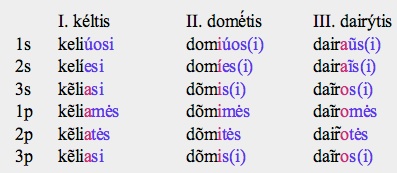
-
2) reflexive: kéltis ('to get up'), domė́('to be interested in'), dairýtis ('to look around').
-
-
black: stem
-
red: stem vowel
-
blue: personal endings.
-
In conjugation I, the stem vowel a is lost in the 1st and 2nd singular.
-
In conjugation II, the stem vowel ė is replaced by i. In the 2nd singular the stem vowel is lost.
-
In conjugation III, the stem vowel o is replaced by a in the 1st and 2nd singular.
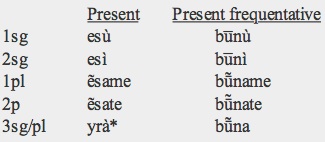
-
An important irregular verb is bū́ti ('to be'); its present is formed with the stem es-:
-
-
*yrà is formed with a different root, and has a variant ẽsti.
-
✴Simple Past indicative. It has frequentative and non-frequentative forms.
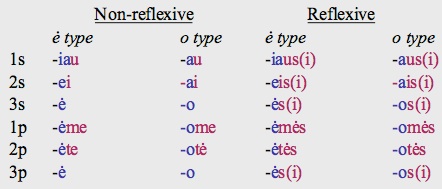
-
1) the non-frequentative is formed with the root plus suffixes ė or o (like conjugation III). It has non-reflexive and reflexive forms.
-
All verbs of conjugation II form o-preterites.
-
-
2) the frequentative is formed with the root plus the infix -dav- and the suffix -o. Some examples are:
-
-
gérti ('to drink'): gér-dav-o
-
dìrbti ('to work'): dìrb-dav-o
-
mylė́ti ('to love'): mylė́-dav-o
-
✴The Future indicative is formed from the infinitive by dropping ti and adding si; the personal endings are the same of the present and past tenses.
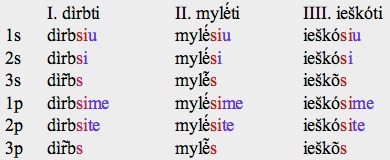
-
B.compound tenses: are formed with the auxiliary verb 'to be' conjugated in the simple present, past and future, plus the active past participle in the nominative, inflected for number and gender.
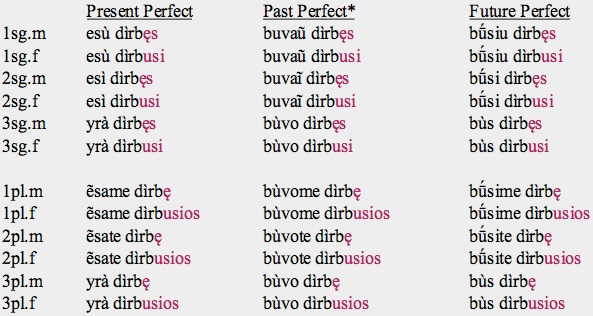
-
*Non-frequentative. Frequentative forms are rare in the past perfect: bū́davau, bū́davai, bū́davo.
-
C.non-indicative moods:
-
✴Imperative: the conjugation of the imperative mood is based on the infinitive stem, to which is added the suffix -k for the second person singular. For the second person plural the suffix -ite is added after -k: 2 sg. dìrb-k; 2 pl. dìrb-k-ite.
-
There is also a form for the first person plural which adds the suffix -kime to the stem e.g. eĩkime (‘let's go!’).
-
✴Permissive/Optative: it has only 3rd person, and is formed with the particle tè or tegu(l) added to the 3rd person of the present indicative: tegu(l) ateĩna or teateĩna (‘may he/she/they come!’).
-
✴Subjunctive: has a present and a past tense.
-
The present subjunctive is formed on the basis of the infinitive stem plus the following endings: 1s -čiau, 2s -tum(ei), 1p -tume, 2p -tute, 3s/p: -tų.
-
The past subjunctive is formed with the past active participle (masc/fem, sg/pl) plus the auxiliary bū́ti in the present subjunctive form. The present and past subjunctive forms of pir̃kti (‘to buy’) are:
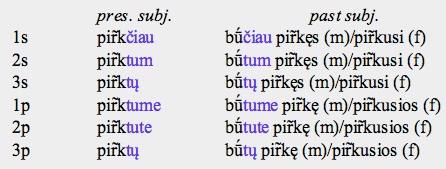
-
The subjunctive passive is formed with the auxiliary bū́ti in the present subjunctive plus a passive participle.
-
✴Relative: like the indicative, the relative mood has three simple and three compound tenses, with active and passive voices.
-
Simple tenses: use the present, past and future forms of the participles in the function of a finite main verb.
-
Compound tenses: combine the past participle of the main verb with the present, past and future participles of the auxiliary bū́ti.
-
The passive is formed by combining passive participles of the main verb with the present, past and future participles of the auxiliary bū́ti.
-
•non-finite forms: infinitive, verbal noun, gerunds, participles.
-
Lithuanian preserved the whole participial system of the proto-language and expanded it.
-
‣The infinitive is formed with the infinitive stem plus the suffix -ti (-tis in reflexive verbs). It is not declined and has imperfective and perfective forms.
-
‣The verbal noun is derived from the past stem by adding the suffixes -imas or -ymas: klausti (‘to ask’) > klausimas (‘question’), skaityti (‘to read’) > skaitymas (‘reading’).
-
‣Gerunds are undeclinable or partially declinable. When imperfective, they express an action simultaneous with that of the main verb. When perfective, express an action anterior to that of the main verb. When the action is posterior to that of the main verb, the adverb prieš is placed before the gerund.
-
‣Participles. They are inflected for number and gender. There are active and passive ones (eight in total). They also have perfective and imperfective forms.
Word Formation
Employs suffixation, prefixation and compounding.
Suffixation. Derivation can be produced from nouns or verbs. Sometimes verbs are derived from interjections. With the suffix -au(ti) verbs are derived mainly from nouns; -uo(ti), -o(ti), -in(ti) and -inė(ti) are denominal and deverbal, -ė(ti) and -y(ti) are deadjectival and also deverbal, -telė(ti) is deverbal and deinterjectional.
Prefixation. There are a dozen verbal prefixes with different meanings: around, completion, separation, motion, beginning of an action, direction, congregation, etc.
Compounding: compounds may be formed with or without a connecting vowel, with nouns as components, or with adjective plus noun, or with a noun plus a component derived from a verb.
Syntax
Word order: In a declarative sentence word order is flexible because the subject and object(s) may be distinguished through case endings. But it is not completely free because a change in word order implies an alteration in emphasis or focus. The neutral order is generally Subject-Verb-Object (SVO). Other orders are OVS (equivalent to English passive) and non-neutral VSO and VOS. For example:
-
John bought a book (SVO)
-
Book bought John (OVS)
The latter is an active construction equivalent to a passive construction in English (A book was bought by John). The topic has changed from the subject to the object. The topic is always in initial position.
When there are two objects in the sentence, the indirect object (marked by the dative) is placed before the direct object (marked by the accusative): S-V-OI-OD. In this case the indirect object is the topic; if the order is reversed, then the direct object is the topic. When both objects are pronominalized they are placed in preverbal position: "the teacher to him it gave" (the teacher gave it to him).
When there is an adverbial, S-V-Adv and Adv-V-S orders are possible; it depends on the topic. If the adverbial is the topic it comes in initial position. Two or more adverbials can be placed at the beginning of the sentence. Generally, adverbials are placed before the verb. For emphasis the adverbial may be postpositioned.
Attributes (adjectives and numerals) precede the head noun in this order:
-
determinative pronoun-demonstrative-possessive-adjective-head noun
-
visos šitos mano gražios gėlės
-
all these my beautiful flowers
Attributive adjectives agree in gender, number and case with the head noun. The subject and the nominal part of the predicate agree in gender, number and case.
The possessor, marked by the genitive, is placed before the possessed noun.
First and second personal pronouns are generally omitted when in subject position, except to give emphasis. The third person copulative verb in the present tense is usually omitted.
For yes/no questions the interrogative particle ar, placed at the beginning of the sentence, is used. For specific questions, interrogative pronouns or adverbs are used. The most common negation particle is ne which is prefixed to the negated word (a verb, a noun): jis nekalbe (‘he does not speak’); nelaimė (‘misfortune’). Other negation particles are nė, nei and nie. Nė can be used to strengthen the negation: tu nė to nežinai (‘you don't know even that’); used twice (nė.......nė) is like ‘neither ....nor’. Nie is used to negate adverbs and pronouns, it must be reinforced by nė.
Lexicon
Most of it is inherited from Proto-Baltic, but many loanwords were adopted from Latvian, Russian and Polish. Today Lithuanian has also many English borrowings.
Basic Vocabulary (tone and stress marking is shown only in numerals)
one: viénas (masc.), vienà (fem.)
two: dù (masc.), dvì (fem.)
three: trỹs
four: keturì (masc.), kẽturios (fem.)
five: penkì (masc.), peñkios (fem.)
six: šešì (masc.), šẽšios (fem.)
seven: septynì (masc.), septýnios (fem.)
eight: aštuonì (masc.), aštúonios (fem.)
nine: devynì (masc.), devýnios (fem.)
ten: dẽšimt
hundred: šim̃tas
father: tėvas
mother: motina
brother: brolis
sister: sesuo
son: sūnus
daughter: dukra, duktė
head: galva
face: veidas
eye: akis
hand: ranka
foot: pėda
heart: širdis
tongue: kalba
Key Literary Works (forthcoming)
-
© 2013 Alejandro Gutman and Beatriz Avanzati
Further Reading
-
-'Lithuanian'. S. Young. In Concise Encyclopedia of the Languages of the World, 646-648. K. Brown & S. Ogilvie (eds). Elsevier (2009).
-
-Lithuanian Grammar. V. Ambrazas (ed). Baltos Lankos (1997).
-
-A Short Grammar of Lithuanian. T. Mathiassen. Slavica (1996).
Lithuanian

Address comments and questions to: gutman37@yahoo.com
MAIN LANGUAGE FAMILIES
LANGUAGE AREAS
Languages of Ethiopia & Eritrea
LANGUAGES by COUNTRY
LANGUAGE MAPS
-
• America
-
• Asia
-
Countries & Regions
-
-
Families
-
• Europe
-
• Oceania